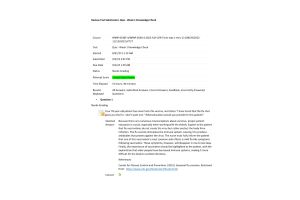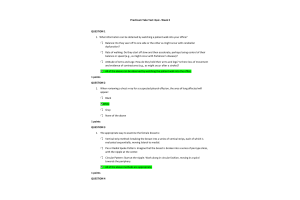NRNP 6540 Week 6 Midterm Exam (100% Correct)
- $55.00
- Question: Geriatric assessments can be challenging for the health-care provider due to delay of recognition and/or reporting of symptoms by the patient. Which of the following best describes what is used by health-care providers to address this differential?
- Question: A patient complains of dry, irritated, and itchy skin that has not been relieved with over-the-counter medications. On examination, the patient is also found to present cholestasis and jaundice. From which of the following conditions may the patient be suffering?
- Question: Which of the following terms refers to conditions that have multiple underlying factors and may involve multiple organs?
- Question: Question: Oral cancer is a malignant tumor presented by a non-healing sore in the mouth or lip that causes difficulty chewing or swallowing. Which of the following statements applies to an oral cancer diagnosis?
- Question: Mr. Osorio is a 65-year-old male who recently retired because of a medical condition. He has good family support and is very motivated to start a wellness program to prevent worsening of his condition. These factors are an example of:
- Question: Mr. Thomas comes in for a health examination with his nurse practitioner. When the nurse practitioner measures his blood pressure, the systolic is 150 mm and the diastolic is 80 mm. When Mr. Thomas asks if that is a good pressure for him, the nurse practitioner responds:
- Question: Understanding that the current life expectancy is 79 years, the nurse practitioner plans a patient’s health promotion while considering which of the following?
- Question: For which of the following evaluations should the patient be referred when sleep impairment is involved with chronic rhinitis?
- Question: Many adults find reasons or barriers for not being able to exercise. Which of the following is an example of a patient barrier?
- Question: Which of the following is the focus of additional studies about the relationship between physical activities and cognitive changes?
- Question: Wandering in older adults can occur with disorientation or cognitive impairment and is characterized as locomotion in a seemingly aimless pattern. From which of the following conditions can wandering arise? Select all that apply.
- Question: Challenges to increasing physical activity are different for everyone. For instance, some patients may be experiencing depression or loss, some may have had significant life changes, and others may be dealing with functional limitations. As relates to increasing physical activity, these are examples of what?
- Question: Bertha is an 85-year-old grandmother who has multiple morbidities. Family members report that Bertha is not eating much and does not seem as active as usual. They want the nurse practitioner to order tests to identify what is happening to her. The nurse practitioner considers which of the following before ordering any tests? Select all that apply.
- Question: Ms. Samuels, 74 years old, comes to the clinic with concerns about her breathing. She states that she is having trouble with mucus collection and difficulty coughing it out and wants to know why? The nurse practitioner tells the patient:
- Question: An older woman is seen in the ambulatory clinic for a routine checkup. The patient asks about results of her blood work compared to last year’s results. How is it best for the clinician to respond?
- Question: In conducting a CGA, the nurse practitioner looks for any impairments in communication with the patient. The assessment includes:
- Question: A family member comes into the clinician’s office with her older mother, the patient. In the process of the examination, the nurse practitioner identifies the patient as “frail older adult.” The family member asks what that means. The nurse practitioner explains that this refers to:
- Question: The nurse practitioner conducts a comprehensive geriatric assessment of the older individual because:
- Question: For individuals over 65 years old, the most common morbidities are related to:
- Question: In the assessment for peripheral vascular disorders, the clinician should begin with which of the following after the general history and physical examination?
- Question: Which of the following is the correct term for the eye condition that presents a sterile mass on the eyelid that is painless and has no reddening?
- Question: Mrs. Khan is 89 years old and is reported to have bouts of agitation. The nurse practitioner is counseling her family that these periods of agitation can be triggered by which of the following?
- Question: The nurse practitioner and a student are examining the apical pulse of an 82-year-old man. The student perceives that there is an S4 sound. The nurse practitioner interprets that this is likely:
- Question: Mrs. Williams is 76 years old and comes in to have a wound checked on her right leg. She fell a month ago and the wound has not healed. She is concerned that something is wrong. The nurse practitioner examines the wound and sees that it has been cleaned properly and has no signs of infection. The edges are approximated, but the skin around the wound is red and tender to touch. The best response regarding Mrs. Williams’ concern is:
- Question: The most common diagnostic test for AR is skin testing that involves scratching the surface of the skin with a single stylus for each allergen. Which of the following are possible if further testing is needed? Select all that apply.
- Question: Mrs. Smith, 75 years old, reports that she is weak, has difficulty urinating, and is dehydrated. Although she is afebrile, the nurse conducts a thorough physical examination, including urinalysis and complete blood count (CBC). The total assessment is necessary because:
- Question: Mr. Jones, a 70-year-old male, visits the urgent care and presents symptoms of unilateral eye pain, visual blurring with halos around lights, red eye, and photophobia. He also reports nausea and vomiting. Visual acuity shows a loss in the affected eye. He is immediately referred for a complete ophthalmic examination. Which of the following conditions may Mr. Jones be experiencing?
- Question: A patient comes to the health-care provider office for a checkup. The nurse practitioner notes that the patient is 67 years old and is presenting symptoms of dizziness, orthopnea, and edema. The nurse practitioner begins a focused assessment of the:
- Question: The nurse practitioner is concerned with primary prevention strategies. How can the nurse practitioner implement primary prevention strategies for an 80-year-old male patient who smokes?
- Question: Stan is 64 years old and has been feeling weak, lightheaded, and slightly nauseous. He goes to the urgent care center where the nurse practitioner initiates an assessment. Which of the following suggest an arrhythmia?
- Question: Mrs. Prentiss is diagnosed with symptomatic AAA. The initial treatment is aggressive blood pressure control. At which of the following readings should mean arterial pressure be maintained?
- Question: Mrs. Williams, 80 years old, asks her nurse practitioner to order a new alternative therapy for her. Mrs. Williams believes that this botanical supplement will provide pain relief for her fibromyalgia. The nurse practitioner explains that this therapy is likely not covered by Medicare because:
- Question: The treatment for cellulitis includes which of the following?
- Question: Mrs. Martinez is 75 years old and has had type 2 diabetes for 25 years. She sees her nurse practitioner on a regular basis. Mrs. Smith asks the nurse practitioner why her treatment has not been changed, even though her laboratory values are seemingly out of normal range. Which of the following is the best response?
- Question: The focus of advanced nurse practitioners is primary care. This is defined as activities that focus on:
- Question: A 67-year-old female patient comes in for an office visit presenting symptoms of nasal congestion, itching, and sneezing and is diagnosed with rhinitis. Which of the following is true about the types of rhinitis?
- Question: Which of the following statements best describes “cough”?
- Question: The nurse practitioner sees a patient in the emergency department with reports of chest pain and nausea. To analyze the patient’s condition, what further information is needed?
- Question: Mr. Borden is 79 years old and lives with his daughter. The daughter provides excellent care for her father and wants to know which changes in his heart and circulatory system are due to aging and which are due to lifestyle choices. The nurse practitioner replies:
- Question: Mrs. Keating is a 70-year-old woman suffering from arthritis. She is seeing the nurse practitioner for her regular checkup. For a person with chronic degenerative conditions, which of the following should the nurse suggest for health promotion?
- Question: The nurse practitioner identifies a late cardiac murmur in an older adult patient. This type of murmur is most often due to which of the following?
- Question: Mr. Thomas comes in for a health examination appointment with his nurse practitioner. He asks why nurse practitioners are qualified to conduct these evaluations. Which of the following is the nurse practitioner's best response? The nurse practitioner:
- Question: The daughter of a 70-year-old woman asks the nurse practitioner why her mother has had a change in functional ability recently. The mother has regularly been drinking for 40 years, however, her behavior is changing. The nurse practitioner replies that:
- Question: The nurse practitioner is assessing a 69-year-old man for possible bipolar disorder. Which of the following are specific for diagnosing bipolar disorder?
- Question: The nurse practitioner is seeing patients in the respiratory clinic. An 85-year-old woman comes in with concerns about having difficulty breathing. When considering asthma, the nurse practitioner asks which of the following questions?
- Question: Medications that may cause orthostatic hypotension include:
- Question: When evaluating a patient with chronic cough, it is not recommended to suppress cough in a patient with stable COPD.
- Question: The American Academy of Ophthalmology recommends comprehensive eye examinations every 1 to 2 years for people ages 65 years and older.
- Question: The nurse practitioner assesses a patient’s skin and finds an infectious lesion on the lower leg. The lesion is considered a secondary lesion. The nurse practitioner explains that a secondary lesion is one that:
- Question: The nurse practitioner is preparing discharge instructions for a 79-year-old man with newly diagnosed asthma. Which of the following are important instructions to include? Select all that apply.





















